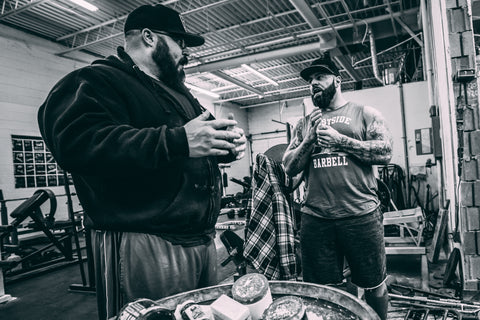Starting Conjugate: Enhancing Work Capacity

The Conjugate Method can be used to focus on and improve a variety of athletic traits and abilities. Whether an athlete needs to improve their absolute strength, explosive power, physical composition, or overall fitness, our methods can be tailored to achieve various training goals. Unlike linear periodization, where extended training phases are dedicated to improving one aspect of athleticism, the Conjugate Method can improve multiple athletic abilities simultaneously.
One crucial aspect of athleticism we focus on is the development of work capacity. Work capacity refers to the training volume and intensity an athlete can tolerate while maintaining a steady recovery schedule and making positive training adaptations. Ultimately, an athlete's work capacity plays a significant role in dictating the level of strength, speed, and fitness an athlete can achieve.
If an athlete seeks to improve continuously, they must enhance their ability to train at increased training volume and intensity levels. As we know, once the athlete acclimates to a specific volume and intensity level, the adaptations become less and less significant. Without increasing training volume and intensity over time, the athlete will experience the effects of accommodation, leading to strength plateaus and slowed improvement.
At Westside, we are always focused on improving the work capacity of our athletes. Whether an athlete is focused on powerlifting, strongman, football, or combat sports, improving work capacity is essential to enhance athletic performance continuously. Below, we will discuss a few programming strategies we use to improve work capacity without modifying the typical Conjugate Method training schedule.
Back-Off Sets
Each training day will feature a main exercise when following a Conjugate Method training plan. These are multi-joint exercises intended to increase an athlete's absolute strength or explosive power. However, these movements can also be used to enhance hypertrophy and work capacity when back-off sets are used.
For example, say an athlete works up to a top set of 800lbs for a single rep in the back squat. If we wish to enhance work capacity, we will have this athlete perform 2-3 back-off sets, performing 5-10 total reps per set. To accomplish this work, the athlete will lower the training weight to allow for multiple sets and reps to be performed. Here's how it would go:
Top Set: 800lbs
Back-Off Set 1: 600lbs x 5 reps
Back-Off Set 2: 560lbs x 5 reps
Back-Off Set 3: 520lbs x 5-8 reps
Once the top set has been achieved, we will perform back-off sets using 75%, 70%, and 65% of the top set weight for multiple reps. These percentages are most typically used. However, back-off set training percentages can be slightly increased or decreased to match the athlete's fitness level and ability. Additionally, back-off set rep counts can differ depending on the athlete.
After a few months of using back-off sets, athletes should expect improved work capacity and muscle mass due to the increased training volume and hypertrophy.
Accessory Exercise Training Volume
The next way to enhance work capacity is by increasing accessory exercise training volume. We can go about this a few different ways, most commonly by modifying the set and rep schemes of specific exercises or increasing the number of accessory exercises we perform. The goal is to gradually increase the work performed without negatively impacting the typical recovery rate.
Here is how we would go about increasing accessory exercise volume to improve the work capacity of an athlete:
Standard Lower Body Accessory Training:
Exercise 1 - Romanian Deadlift, 4 x 8-10
Exercise 2 - Belt Squat, 3 x 10-12
Exercise 3 - Inverse Curl, 3 x 8-10
Exercise 4 - Reverse Hyper, 4 x 12-15
Exercise 5 - GHR Sit-Ups, 4 x 15-20
Work Capacity-Focused Lower Body Accessory Training:
Exercise 1 - Romanian Deadlift, 4 x 8-10
Exercise 2 - Belt Squat, 4 x 12-15
Exercise 3 - Inverse Curl, 4 x AMRAP
Exercise 4 - Reverse Hyper, 4 x 15-20
Exercise 5 - GHR Sit-Ups, 5 x 20-25
We have slightly increased the accessory exercise training volume compared to the standard lower-body training plan. Instead of adding new exercises, we added a few additional sets and reps to existing exercises. This will allow for work capacity improvement without significantly adding to the recovery burden associated with the initial lower body accessory training plan.
Increasing work capacity via accessory exercise training does not require significant changes to be made to a training plan. The goal is to gradually increase the training volume without impacting the quality of the training. An athlete should be capable of performing the additional sets and reps with proper form; the athlete should not be tired to the point that technical execution is affected.
Conditioning Work
The final way to enhance work capacity is to increase the amount of conditioning training an athlete performs during each training day.
At Westside, we typically include at least one conditioning-focused exercise in our training plan each training day. This work will often involve a sled drag, a carry, or a high-volume exercise. When adding conditioning work to a training plan, it is crucial to ensure the conditioning training fits the current workout and the athlete's typical recovery rate.
For instance, if we are dealing with an out-of-shape athlete who struggles to perform a basic training day, we would want to avoid ending the day with excessive conditioning work. This would further add to the overall recovery burden experienced by the athlete and place the athlete at an increased risk of injury.
When coupled with barbell training, conditioning work aims to improve the athlete's conditioning training tolerance and capability gradually; we do not want to obliterate and destroy the athlete. When programmed correctly, conditioning work can significantly improve work capacity and help improve an athlete's rate of recovery.
Here is how we would go about increasing work capacity using conditioning-focused training:
Normal Conditioning Training:
Exercise 1 - Forward Sled Drags, 10 trips, 15-20 yds per trip
Work Capacity-Focused Conditioning Training:
Exercise 1 - Forward Sled Drags, 12 trips, 25-30 yds per trip
Exercise 2 - Belt Squat Walk, 4 x 60 steps
The approach here is simple. We added a few trips to the sled drags while increasing the distance the sled is pulled. Additionally, we added belt squat walks to further condition the lower body with a specific focus on the hips. This training will improve overall conditioning and enhance the work capacity of the lower body when performing strength and cardiovascular-focused tasks.
Minor Adjustments Lead to Significant Improvements
A common mistake athletes make is mismanaged adjustments to their training plans. As the expected rate of improvement decreases, many athletes believe that large-scale changes must be made to their current training plan. However, it is more likely that slight adjustments to their current training would be far more beneficial.
When we make minor adjustments to our training, it becomes easy to recognize the effects caused by these adjustments. At that point, further training optimization becomes possible due to the athlete having a clear understanding of the training effects currently taking place. If an athlete completely changes their training plan and approach, points of reference are lost, and it becomes difficult to control and modify training effects and outcomes.
Just as a marksman makes minor adjustments to their aim when a target is missed, an athlete should make minor adjustments to their training when results and outcomes are less than satisfactory. Often, a few simple modifications to an existing training plan will provide the improvements and adaptations an athlete currently seeks.
While there are times when a complete overhaul of the training plan is called for, minor adjustments can often lead to significant improvements in training outcomes and sports performance.
Sources:
Simmons, L. (2007). Westside Barbell Book of Methods. Westside Barbell.
Verkhoshansky, Y., & Siff, M. C. (2009). Supertraining. Verkhoshansky.
Zatsiorsky, V. M., & Kraemer, W. J. (2006). Science and Practice of Strength Training. Human Kinetics





